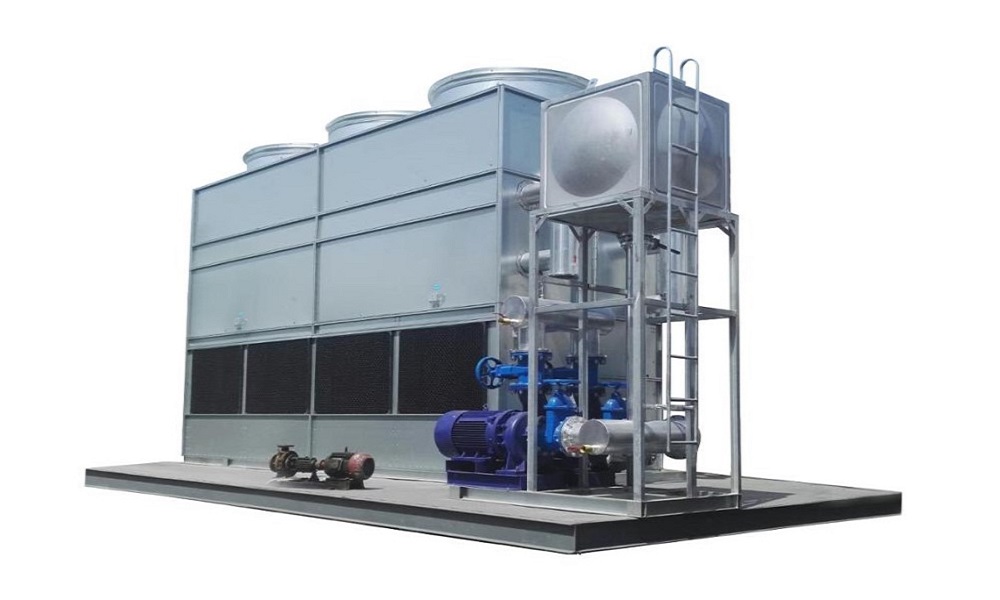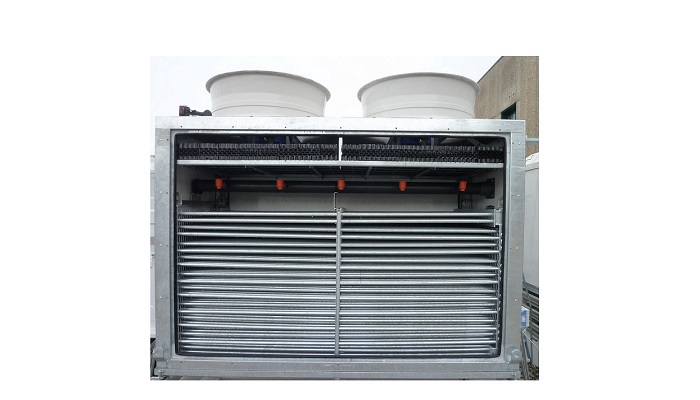Many things can operate better with the help of evaporative condensers and some of them can’t even work without one. In this article, Linquip wants to introduce evaporative condensers and explain their advantages and disadvantages. We also explain their applications and elaborate on the way they work. So, get ready to dive into some useful information about them.
What is Evaporative Condenser?
First things first, let’s see what this system is. Evaporative condenser is a system that enables the removal of the excess heat from a cooling system. Keep in mind that the heat will be removed when it no longer serves for any purposes. Evaporating water enables this excess heat to be removed. Condensers can be either water-cooled, air-cooled, or evaporative. And in this article, our main focus is on the evaporative ones. Their physical principle is the same as cooling towers but with a few differences that we will mention later in this article.
Evaporative condenser diagram
They feature one or more fans, a cabinet and a water-sprayed condenser. A typical one usually contains a hot primary coolant, a cold primary coolant, water sprinkles, cold water, and centrifugal fan in order for the system to provide the desired outcome.
Application of evaporative condenser
Since they enable heat rejection for different types of systems, their application for each type will determine which system is the right choice for your project. They are mostly used in the light industrial market and HVAC market, and their application is that they are used to provide the lower condensing temperature.
How do evaporative condensers work?
The vapor that is about to be condensed will circulate through a condensing coil. The outside of this condensing coil is repeatedly wetted by a recirculating water system. A small portion of the recirculating water evaporates when the air is pulled over the coil. The process of evaporation causes the heat to be removed from the vapor in the coil and causing it to condense.
Evaporative condenser advantages and disadvantages
Every system, even the ones with lots of advantages, has some disadvantages. Here, we will talk about some of the most important advantages and disadvantages of these systems. Evaporative condensers are a little more expensive than other coolants such as dry coolers since they are usually used in systems that have a high outdoor temperature.
The energetic efficiency of these units is among their main advantages as well. Since they use less fan horsepower to run compared to air-cooled design, they can reduce the energy costs significantly and help you save money in the long run. Easy installation and maintenance are also among the advantages of this system.
Regulations in some places around the world sometimes limit the physical size of a cooling system and since evaporative condensers are usually used in large cooling systems, you may need to check the regulation of your location and make sure you don’t have any limits for using this system.
Last but not least is their ability to help space-saving. They are compact and you can use them both in large systems and small systems since they usually require about half the space of comparable air-cooled systems.
Evaporative condenser vs. cooling tower
In this part, we will explain some of the differences between an evaporative condenser and a cooling tower. One of the main differences between them is that in the first one, unlike the other, the primary coolant of the cooling system is cooled.
Although their physical principles are same, the thermal exchange in the cooling towers happens in the filling while in the condenser, it happens in the tubular bundle where the fluid or the water circulates in order to lose the heat.
Another important difference between these two is how long it takes and how many stages it requires to achieve their cooling effects. Cooling towers have two stages to remove heat. The heat should be transferred to the circulating chiller fluid with the help of the condenser unit and then the atmospheric heat rejection takes place. But chillers that feature evaporative condensers have only one step for their heat rejection process.
Different types of evaporative condensers
So, what are different types of this system? Identifying different types are always based on different factors. But one of the most popular categorizations to identify these systems’ different types is the one we’re about to explain. Typically, there are two types of evaporative condensers: counterflow and combined flow. The combined flow uses a condensing coil and fill surface to transfer heat in the system. The designers added the fill surface to the traditional design to help reduce the evaporation in the coil section and also help reducing the potential for fouling and scaling. This type uses parallel air flow and spray water over the coil and also crossflow air or water flow through the fill surface. The parallel flow enables the flow of air and water over the coil in the same direction. And in the fill section of this type, water and air interact with crossflow configuration. Here, the direction of the water is vertical and it flows down the fill while the air flows horizontally across it.
In counterflow evaporative condenser type, the spray water flows vertically down over the coil while the air travels up vertically through the unit. The air flow in this type happens with the help of one or more mechanically driven fans that are either axial or centrifugal.
Centrifugal fan units can handle a reasonable amount of external static pressure and are suitable for outdoor as well as indoor installations, these fans are quieter than axial fans too.
Now that you know all about evaporative condensers, how about sharing your stories and experiences with us? Have you ever used one? Write to us in the comment section and let everyone see your opinion about these systems or about the information on this article. And if you have any questions, feel free to sing up on Linquip website and one of our experts will answer all your questions and help you solve your problems.





Hi
Thanks for sharing the useful blogs about the condenser . please add more blogs about the cooling manufacturers too and how its working process ? Once again very great articles for the cooling industry .
Hello. Thanks for reading our articles. We’re glad you enjoyed reading them. Please signup on Linquip and follow our blog to read our new articles as well. If you have any suggestions, we would appreciate it if you share them with us. Our experts will do researches on the subjects you have in mind and will write articles to answer all your questions.